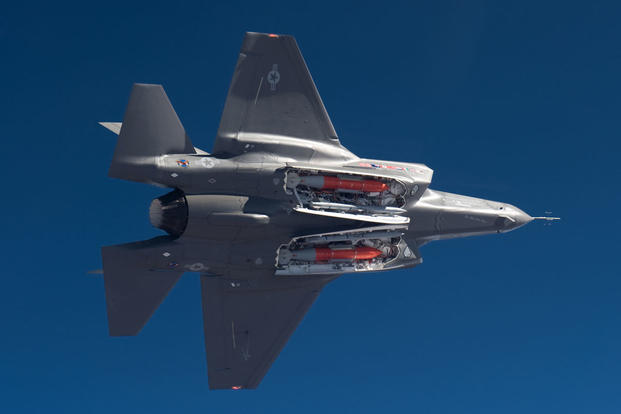The Pentagon's F-35 Joint Program Office is defending its new stealth aircraft in response to a recent news report citing a test pilot's analysis claiming the aircraft proved to be inferior to an F-16 in "dogfighting" test scenarios.
The test pilot assessment, first reported by the "War is Boring" blog, says the F-35A could not out-maneuver an F-16 or avoid being shot in mock dogfight scenarios during testing in January.
Military.com received a copy of the Jan. 14 report, titled "F-35A High Angle of Attack Operational Maneuvers," which says the aircraft lacked the "energy maneuverability" to succeed in air-to-air test dogfighting scenarios against the older aircraft.
"Overall, the most noticeable characteristic of the F-35A in a visual engagement was its lack of energy maneuverability," the report states. "Even with the limited F-16 target configuration, the F-35A remained at a distinct energy disadvantage for every engagement."
Related Video
The test pilot's report also says the "energy maneuverability" of the F-35A is inferior to an F-15E with a Pratt & Whitney 229 engine due to a "smaller wing, similar weight and 15,000 pounds less in afterburner thrust."
"So, in general, the high AoA [Angle of Attack] capabilities of the jet could not be used in an effective way without significantly reducing follow-on maneuvering potential," the report says.
The test pilot's assessment also claimed that the F-35 helmet was too large for the pilot to effectively see behind the aircraft.
"There were multiple occasions when the bandit would've been visible [not blocked by the seat] but the helmet prevented getting in a position to see him," the report says.
The Pentagon's F-35 Joint Program Office, however, while praising and welcoming the test pilot assessments, says the "War is Boring" story leaves out key factors and critical context to the issue.
"The media report on the F-35 and F-16 flight does not tell the entire story. The F-35 involved was AF-2, which is an F-35 designed for flight sciences testing, or flying qualities, of the aircraft. It is not equipped with a number of items that make today's production F-35s 5th Generation fighters," a JPO office written statement said.
In particular, the JPO statement explained that the AF-2 test aircraft did not have the mission systems software designed to utilize the aircraft's next-generation sensors.
In short, the F-35 is engineered with a suite of next-generation sensors designed to help the aircraft recognize, detect and destroy enemy targets at longer distances -- long before it can be identified by an enemy aircraft.
"While the dogfighting scenario was successful in showing the ability of the F-35 to maneuver to the edge of its limits without exceeding them, and handle in a positive and predictable manner, the interpretation of the scenario results could be misleading. The F-35's technology is designed to engage, shoot, and kill its enemy from long distances, not necessarily in visual 'dogfighting' situations," the JPO said.
The F-35 office also said the AF-2 test aircraft was not equipped with the F-35's special stealth coating designed to make the aircraft invisible to enemy radar.
In addition, the JPO statement said the AF-2 "is not equipped with the weapons or software that allow the F-35 pilot to turn, aim a weapon with the helmet, and fire at an enemy without having to point the airplane at its target."
Finally, the F-35 office says simulated combat scenarios have shown that four F-35s have won encounters when pitted against a four-ship of F-16s.
"The F-35s won each of those encounters because of its sensors, weapons, and stealth technology," the statement said.
The F-35 is engineered to accomplish what's referred to as "sensor fusion," namely the technological ability to fuse relevant information from a variety of sources into one common operating picture for the pilot to view -- such as digital maps, radar information and sensor information all combined into a single set of screens, Pentagon officials explained.
The idea is to enable F-35 pilots to see and destroy enemies in the air well in advance of a potential dogfight scenario. This can be explained in terms of a well-known Air Force strategic concept referred to as the "OODA Loop," for observe, orient, decide and act. The concept is to complete this process quickly and make fast decisions while in an air-to-air dogfight -- in order to get inside the enemy's decision cycle, properly anticipate, and destroy an enemy before they can destroy you.
The F-35 is designed with long-range sensors and data fusion technologies such that, as a fifth-generation aircraft, it can complete the OODA Loop much more quickly than potential adversaries, F-35 advocates and JPO program officials claim.
For instance, the F-35's Electro-Optical Target System, or EOTS, is an infra-red sensor able to assist pilots with air and ground targeting at increased standoff ranges while also performing laser designation, laser range-finding and other tasks.
In addition, the plane's Distributed Aperture System, or DAS, is a series of six electro-optical sensors also able to give information to the pilot. The DAS includes precision tracking, fire control capabilities and the ability to warn the pilot of an approaching threat or missile.
The F-35 is also engineered with an Active Electronically Scanned Array Radar, which is able to track a host of electromagnetic signals, including returns from Synthetic Aperture Radar, or SAR. This paints a picture of the contours of the ground or surrounding terrain and, along with Ground Moving Target Indicator, or GMTI, locates something on the move on the ground and airborne objects or threats.
The F-35 software, which shows images on display screens in the cockpit as well as on a pilot's helmet-mounted-display, is able to merge results from various radar capabilities onto a single screen for the pilot.
However, despite the F-35's technologies and next-generation sensors, the JPO statements did not seem to necessarily contradict the central finding of the test pilot's assessment that, in terms of pure dogfighting maneuverability as its own variable, the F-35 did not perform as well as an F-16.
-- Kris Osborn can be reached at Kris.Osborn@military.com.




























